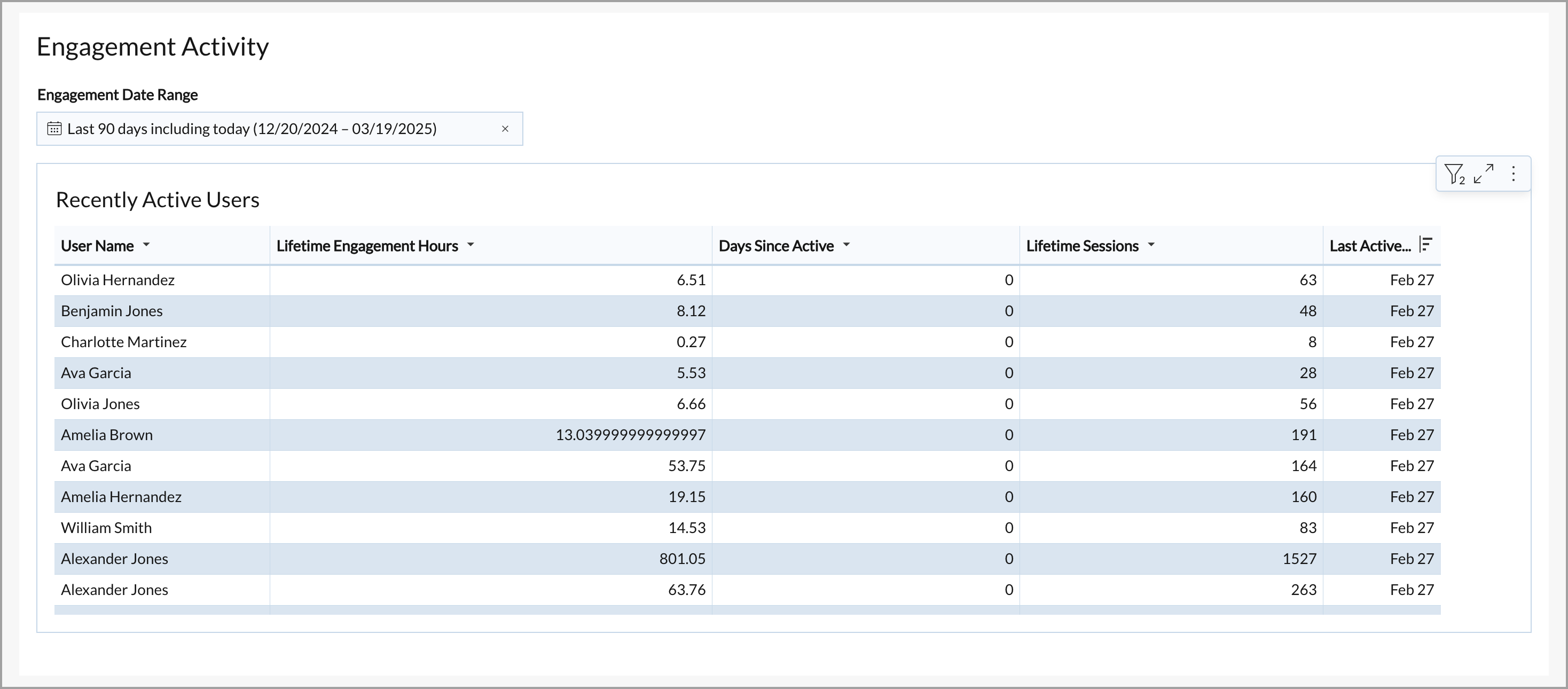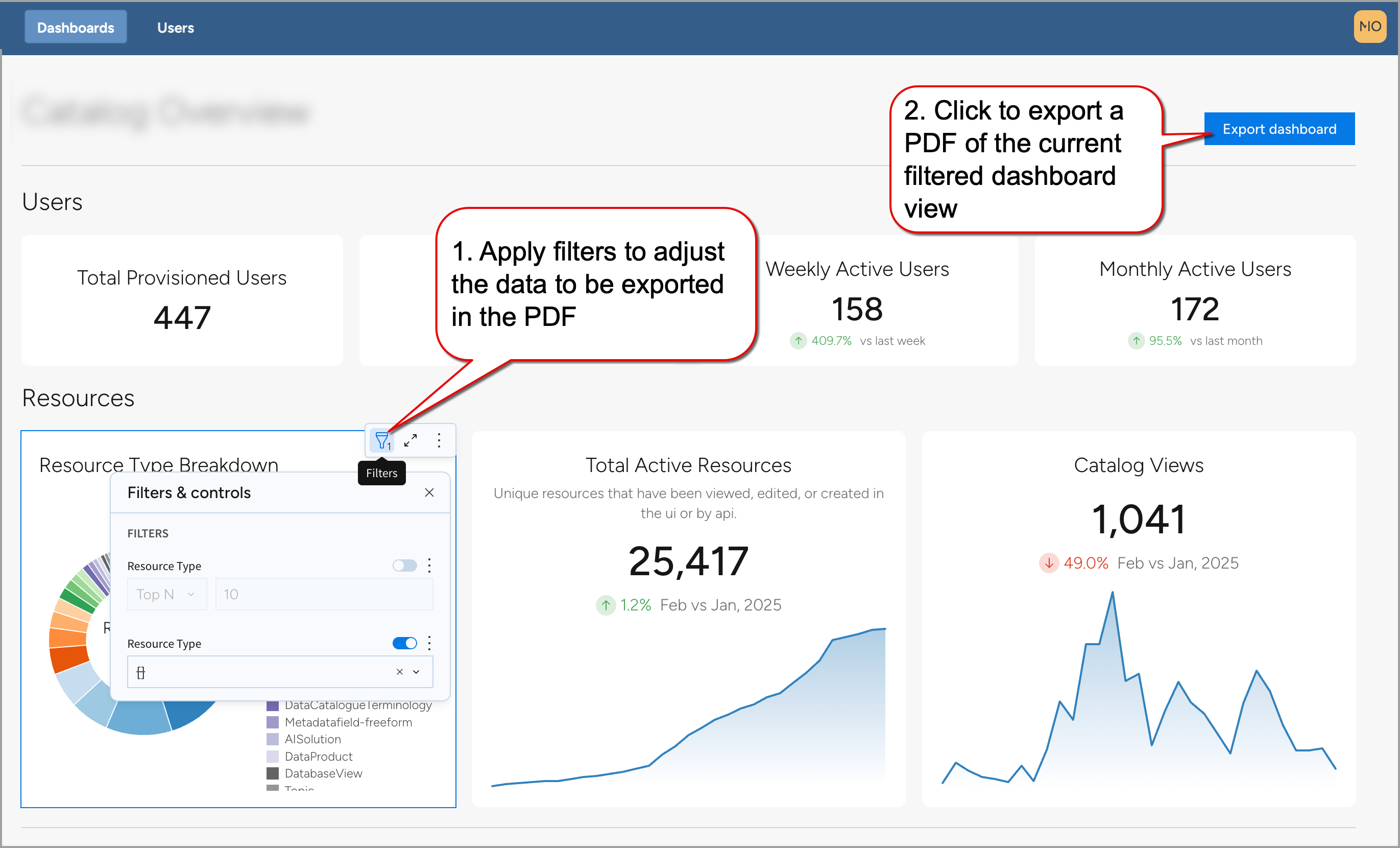Viewing engagement dashboards
Engagement Dashboards provide insights into user activity, helping track how often users engage with data.world.
Use these dashboards to:
Identify highly engaged users by analyzing their total engagement time and session counts.
Monitor user activity trends to understand who is actively using the platform and how engagement changes over time.
Optimize content and resource distribution based on user interaction data.
Key engagement dashboards
Explore the following dashboards with key metrics available on the Engagement dashboard page.
Engagement metrics
This section helps monitor user activity trends, identifying power users and engagement behaviors.
Dashboard | Details | Source for the dashboards |
|---|---|---|
Top 10 Users - Total Engagement Time (Hours) | Displays the top users based on total hours spent interacting with the platform, helping recognize power users. |
|
Top User (Sessions) | Shows the user with the highest number of sessions, identifying frequent platform visitors. |
|
Top Creator (Total Resources) | Highlights the user who has created the most resources, helping measure content contributions. |
|

Engagement activity
Analyze how frequently users interact with the platform to assess retention and activity trends.
Dashboard | Details | Source for the dashboards |
|---|---|---|
Recently Active Users | Displays recent user activity, including lifetime engagement hours and last active day, helping track retention trends and cumulative engagement. |
|
Most Resources Added | Users who added most resources to the catalog. |
|
Most Resources Updated | Users who updated most resources in the catalog. |
|

Exploring user engagement on the dashboard
To explore engagement data on the dashboard:
Go to the Dashboards page and click Engagement in the left pane.
The dashboard displays key engagement metrics.
To export the entire dashboard view, click the Export dashboard button. This captures a snapshot of all visible widgets and applied filters as a PDF — ideal for sharing, reporting, or archiving. For details, see Exporting dashboards
To export data or visualizations from individual dashboards, hover over any widget and click the Three-dot menu > Export. Available formats include CSV, JSON, Excel, PNG, and others.
Click the Three dot menu in any dashboard and select Refresh data to update the dashboard.
To expand a specific dashboard, hover over it and click Maximize Element. The expanded view shows a detailed view of the underlying data of the dashboard elements.
Filtering and analyzing user engagement
Each dashboard includes filter options to refine data and analyze engagement trends in detail.
To filter and analyze user engagement trends:
To apply a filter on all dashboards on the page, click the Global Filters button. In the Global Dashboard Filters window, select from the following:
Select Exclude Users by Selection to remove specific users from the dashboards.
Use Filter Users by Email Text to filter out users by specific criteria.
To use the filters for specific dashboard, hover over a dashboard and click Filters.
Use the following filtering options for the Top 10 Users - Total Engagement Time (Hours) dashboard:
Lifetime Engagement Hours: Adjust the number of displayed users beyond the default top 10 to expand or narrow the list.
Use the following filtering options for the Engagement Activity dashboard:
Engagement Date Range: Define a custom timeframe to analyze Recently Active Users. Click the dropdown menu and select a predefined range (for example, Last 90 days). Check Include Today to incorporate the latest data.
Days Since Active: Adjust this setting to focus on users based on their last interaction date.
Sort and organize data:
Click the Column header name in the dashboard to access sorting options. Use available sorting options to arrange data effectively.
Click Column details to view summaries and insights about a specific column.
Copying and analyzing data:
Right-click any value inside a table and select Copy to clipboard to copy specific data values.
Use sorting and filtering tools to focus on specific engagement trends and high-value users.
Exporting dashboards
You can export the entire dashboard view as a PDF file. This is useful for sharing dashboard insights with others, archiving reports, or including snapshots in presentations.
The export captures all visible charts and widgets on the page, along with any filters that are currently applied.
To export the dashboard as a PDF:
Apply filters to customize the data shown in the export. For example, you can filter by date range, resource type, or specific metrics to tailor what appears in the final PDF.
Click the Export dashboard button at the top of the page.
The PDF file is saved automatically to your local device. The export reflects the current visible state of the dashboard, including all applied filters and settings.
